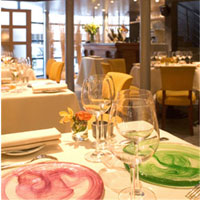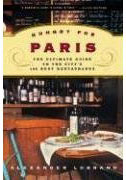 Some ten years ago, I went to dinner one night with no expectations. A London newspaper had asked me to write about Laperouse, an old warhorse of a restaurant overlooking the Seine on the Left Bank—it was doing historic Paris restaurants, and this one’s been around forever. I politely suggested that there might be better candidates, because as far as I knew, this place was still a slumbering tourist table flogging its past: it has several charming tiny private dining rooms with badly scratched mirrors—as the legend goes, these cuts were made by ladies testing the veracity of newly offered diamonds (real diamonds cut glass).
Some ten years ago, I went to dinner one night with no expectations. A London newspaper had asked me to write about Laperouse, an old warhorse of a restaurant overlooking the Seine on the Left Bank—it was doing historic Paris restaurants, and this one’s been around forever. I politely suggested that there might be better candidates, because as far as I knew, this place was still a slumbering tourist table flogging its past: it has several charming tiny private dining rooms with badly scratched mirrors—as the legend goes, these cuts were made by ladies testing the veracity of newly offered diamonds (real diamonds cut glass).
The editor was unyielding, so off I went. The stale-smelling dining room was mostly empty on a winter night, and though the young mâitre
d’hôtel was unexpectedly charming and gracious, I was more interested by my friend Anne’s gossipy accounts of a recent visit to Los Angeles than I was by the menu.
Then we were served an amuse-bouche, or complimentary starter, which the mâitre
d’hôtel described rather unpromisingly as “milk soup.” The small shot glass was warm to the touch, and there was something black and brown, fine and grainy floating on the frothy surface of the soup. I tasted it and instantly knew what it was—toast crumbs. The chef had scrapped toast crumbs into his soup, and I was galvanized by this garnish for being so ingenuous, homely, and oddly delicious.
When the mâitre
d’hôtel came to clear away our shots, he asked if we enjoyed the soup. I said I liked it very much, especially the toast crumbs, and he did a double-take. ”Yes,” he stumbled—the only time I’ve ever known him to—“yes, they are toast crumbs,” and at the end of the meal, which was superb, the chef, a slight, elfin man with a wry but gentle smile stopped by our table.
We chatted, and he told me that he and his colleague had previously worked at Aprège, chef Alain Passard’s thumpingly expensive place in the rue de Varenne, and had just moved over here. A few weeks later, however, eager to repeat the experience and discover more about them, I booked at Lapérouse again, and my hopes were dashed by exactly the type of polite, ordinary, expensive meal I’d originally been expecting. They were gone.
 A few months later, though, I had a postcard from them (I’d left my card). Chef Pascal Barbot and mâitre
d’hôtel Christophe Rohat were opening a little restaurant in the rue de Beethoven in the 16th Arrondissement. I was there the first week their new place L’Astrance—named for a wildflower in Barbot’s native Auvergne—was open and had one of the best meals I’ve ever eaten.
A few months later, though, I had a postcard from them (I’d left my card). Chef Pascal Barbot and mâitre
d’hôtel Christophe Rohat were opening a little restaurant in the rue de Beethoven in the 16th Arrondissement. I was there the first week their new place L’Astrance—named for a wildflower in Barbot’s native Auvergne—was open and had one of the best meals I’ve ever eaten.
I also had a much longer conversation with Barbot, who once cooked for the admiral of the French Pacific Fleet and lived in Sydney for a while, experiences that changed him.
“While I was in Australia and the Pacific, I became much more interested in fruit and vegetables. The classic ingredients of French cooking, especially cream and butter, didn’t taste good in these settings, so I started experimenting. Working at Arpege, I was also exposed to Alain Passard’s love of vegetables, and all of these things had a big impact on me,” said Barbot.
Since every meal I’ve ever eaten here has been better than the last, I always look forward to L’Astrance, although the difficulty of snaring one of this small dining room’s twenty-six places and the rising prices have made it an infrequent pleasure. Still, at the cusp of late spring, which is one of the loveliest times of the year in Paris, and to celebrate the arrival of some of my oldest friends from San Francisco, I tackled the reservation process the necessary month ahead of time and secured a table for dinner on a night in late May, peony times, when Paris is floral and flirtatious.
 We arrived at this discreet duplex dining room with silvered walls and apricot banquettes and embarked on a wonderful voyage. Christophe Rohat, who has a voice like dark gray velvet, as instrument that perfectly matches his dignified and elegant serving style, suggested a tasting menu with individual wines for each course, and its first note was an amuse-bouche that was spring in a shot glass--warm goat's milk, lemon, fresh peas, and scissored herbs, a vivid, refreshing concoction that foreshadowed the pleasures to come.
We arrived at this discreet duplex dining room with silvered walls and apricot banquettes and embarked on a wonderful voyage. Christophe Rohat, who has a voice like dark gray velvet, as instrument that perfectly matches his dignified and elegant serving style, suggested a tasting menu with individual wines for each course, and its first note was an amuse-bouche that was spring in a shot glass--warm goat's milk, lemon, fresh peas, and scissored herbs, a vivid, refreshing concoction that foreshadowed the pleasures to come.
Barbot's contemporary haute cuisine is a whimsically customized experience. He changes his menu daily, and it varies from table to table according to what Rohat and the kitchen decide you should try. Next up for us was a miniature brioche painted with rosemary butter and accompanied by a tiny ramekin of Parmesan cream, a stunning but potent miniature that brilliantly demonstrates the difference between France's culinary avant-garde and that of Spain. France, that goodness, in not Spain, where dry ice and exploding bonbons have become the norm. No, even at the most creative outer limits of a new, widely traveled generation of chefs, French cooking remains guided by a rigor and refinement that profoundly respects the palate, and instead of chemistry-set antics, Pascal Barbot astonished with his winsome love of flowers, berries, herbs and seeds.
L'Astrance
4, Rue Beethoven
75016 Paris, France
+33 1 40 50 84 40
Excerpted from HUNGRY FOR PARIS: THE ULTIMATE GUIDE TO THE CITY'S 102 BEST RESTAURANTS © Copyright 2008 by Alexander Lobrano. Reprinted with permission by Random House.
All rights reserved



